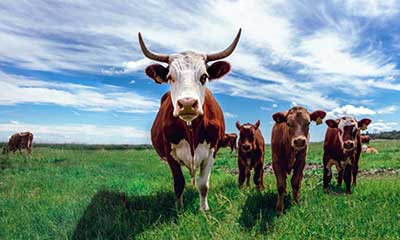Relevance: GS-3: Economics of animal-rearing.
Key phrases: Livestock, rural community, agriculture GDP, Milk, Meat, livelihood, rural economy.
Why in News?
- Livestock is emerging as the most important sector in the Indian agri-food system. Production and consumption of livestock products (milk, milk products, meat and eggs) are increasing rapidly.
Livestock in Indian Economy:
- Livestock plays an important role in Indian economy. About 20.5 million people depend upon livestock for their livelihood.
- India houses the world’s largest livestock population, of about 515 million, and is also the highest producer of milk (about 208 million tonnes), accounting for 22 per cent of the global milk production.
- Similarly, India is the second and sixth largest producer of eggs (114 billion) and meat (8 mt), respectively. However, the productivity on this front is much lower than the world average.
- India has vast livestock resources. Livestock sector contributes 4.11% GDP and 25.6% of total Agriculture GDP.
- The per capita milk consumption is now 394 g/person/day as against the world average of 229 g/person/day.
- Today, milk is India’s largest agricultural commodity in production and value terms. In 2019-20, the value of milk alone was around ₹8-lakh crore as against ₹4.5-lakh crore for rice, wheat and all grains and pulses together.
Why livestock is important for Indian economy?
- The sector has huge potential to increase income, generate employment and empower the poor and marginalised population, including women. It is important for Indian economy due to following reasons:
- Income: Livestock could be a source of supportive income for several families in India, particularly the resource poor who maintain some heads of animals. Like cow and buffalo still provide regular income to cattlemen through the sale of milk and milk-based foods like ghee, curd, buttermilk, cheese, mawa, etc. Livestock provides livelihood to two-third of rural community.
- Employment: An outsized number of individuals in India are less literate and unskilled and rely on agriculture for his or her livelihood. The livestock sector employs 8.8 per cent of the population and provides livelihood to two-thirds of the rural community. Most of the women are engaged in the livestock sector. Therefore, strengthening the livestock sector means pushing rural India towards prosperity.
- Social Security: Animals provide social insurance to owners per their status in society. Families especially the landless who keep their livestock better than those that don’t.
- Livestock contributed 16% to the income of small farm households as against an average of 14% for all rural households.
Constraints faced by the livestock sector:
- First, the availability of quality feed and fodder is a pre-requisite for improving reproduction and productivity. Estimates show that India is short of dry fodder and green fodder by 12 per cent and 30 per cent, respectively.
- The area under fodder cultivation has stagnated at around nine million hectares, which is 4.6 per cent of the total cultivable land, during the past several decades. With rising demand for livestock products, the demand for feed and fodder will grow further.
- Second, poor animal health and diseases lead to low milk and meat yields. Animals are susceptible to several diseases such as foot-and-mouth disease (FMD), brucellosis, or Black Quarter. The annual losses due to only FMD exceeds ₹20,000 crore. If just FMD is controlled, milk production will increase by at least 5-6 per cent per year and export of meat, 3-5 times. Similarly, goat plague is causing a loss of ₹180 crore per year.
- The third, and most important, component is maintaining genetic purity among indigenous animals. This requires semen conservation facilities of indigenous breeds. India is the only country having 50 breeds of cattle, 19 breeds of buffalo, 34 breeds of goat and 44 breeds of sheep. There is a need to strengthen and upgrade at least 400 semen centres to supply quality semen for ensuring conception and fertility in cow and buffalo.
- Fourth, Livestock sector did not receive the policy and financial attention it deserved. The sector received only about 12% of the total public expenditure on agriculture and allied sectors, which is disproportionately lesser than its contribution to agricultural GDP.
Do you know?
- Farmers in India lose almost Rs. 50,000 crores directly every year due to the five fully preventable (with vaccination) diseases. Both Central Government along with state governments spend equally a large amount of funds on vaccination against animal diseases that is almost one lakh crore rupees, the country is losing due to non-reporting diseases, substandard vaccines, inefficient vaccination, ill-education of livestock farmers etc.
Way forward:
- To address these issue, there is a need to develop fodder seed villages, including fodder seed banks. Also, some GST exemption can be considered in the fodder seed supply chain. The inputs and services for seed production are under ‘Exempt Category’, which can be considered to be under ‘zero rated’.
- It is therefore necessary that to improve animal health, a new scheme on the pattern of ‘Ayushman Bharat’, may be launched. A special grant may be allocated to renovate and modernise veterinary hospitals, and also funds may be allocated for constructing modern veterinary hospitals by inviting proposals from States on a 60:40 sharing basis.
- It is time to budget for one “flow cytometer” to at least 100 semen centres for rapid and accurate analysis of sperm function. The well-equipped semen centres can also be developed in public-private partnership mode.
- Strengthening the livestock sector will not only help meet the growing demand for livestock products, but will also enhance farmers’ income, generate employment, empower women and give a fillip to livestock-based processing sectors..
Source: The Hindu BL
Mains Question:
Q. Livestock is emerging as the most important sector in the Indian agri-food system, In light of the statement discuss the role of livestock in farmers’ economy? What are constraints faced by the livestock sector? Illustrate.







